


Wat Mai Suwannaphumaham often simply Wat Mai or Wat May is a Buddhist temple or wat in Luang Prabang, Laos. Built at the turn of the 18th century, it is the largest temple in Luang Prabang. [1]



Wat Mai Suwannaphumaham often simply Wat Mai or Wat May is a Buddhist temple or wat in Luang Prabang, Laos. Built at the turn of the 18th century, it is the largest temple in Luang Prabang. [1]

Luang Phabang, or Louangphabang, commonly transliterated into Western languages from the pre-1975 Lao spelling ຫຼວງພຣະບາງ as Luang Prabang, literally meaning "Royal Buddha Image", is a city in north central Laos, consisting of 58 adjacent villages, of which 33 comprise the UNESCO Town Of Luang Prabang World Heritage Site. It was listed in 1995 for unique and "remarkably" well preserved architectural, religious and cultural heritage, a blend of the rural and urban developments over several centuries, including the French colonial influences during the 19th and 20th centuries.

Wat Xieng Thong is a Buddhist temple on the northern tip of the peninsula of Luang Phrabang, Laos. Built between 1559 and 1560 by King Setthathirath, Wat Xieng Thong is one of the most important of Lao monasteries and remains a significant monument to the spirit of religion, royalty and traditional art.

The Emerald Buddha is an image of the meditating Gautama Buddha seated in a meditative posture, made of a semi-precious green stone, clothed in gold. and about 66 centimetres (26 in) tall. The image is considered the sacred palladium of Thailand. It is housed in the Temple of the Emerald Buddha on the grounds of the Grand Palace in Bangkok.
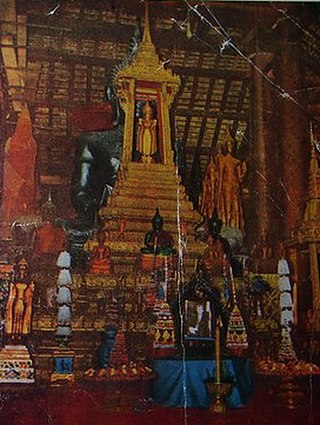
The Phra Bang, Lao is the palladium of Laos. The Lao-language name for the image has been transliterated in a number of ways, including "Pra Bang," "Prabang," "Phabang" and "Pha Bang." The statue is an 83 cm-high standing Buddha with palms facing forward, cast using thong, an alloy of bronze, gold, and silver. According to local lore, it was cast in Ceylon sometime between the 1st and 9th century. However, the features of the image suggest a much later Khmer origin.
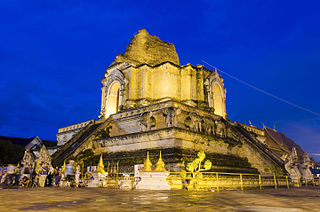
Wat Chedi Luang is a Buddhist temple in the historic centre of Chiang Mai, Thailand. The current temple grounds were originally made up of three temples — Wat Chedi Luang, Wat Ho Tham and Wat Sukmin.
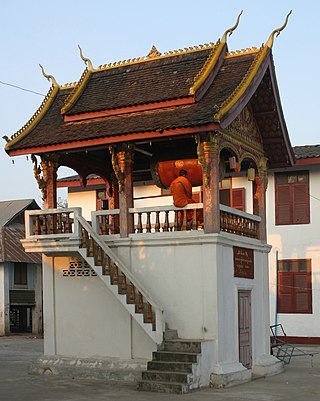
Wat Manorom is a major Buddhist temple and monastery in Luang Prabang, Laos.

Lao New Year, called Pi Mai or less commonly Songkran, is celebrated every year from 13 or 14 April to 15 or 16 April.

The Royal Palace in Luang Prabang, Laos, was built in 1904 during the French colonial era for King Sisavang Vong and his family. The site for the palace was chosen so that official visitors to Luang Prabang could disembark from their river voyages directly below the palace and be received there. After the death of King Sisavang Vong, the Crown Prince Savang Vatthana and his family were the last to occupy the grounds. In 1975, the monarchy was overthrown by the communists and the royal family were taken to re-education camps. The palace was then converted into a national museum.

Sainyabuli, is the capital of Sainyabuli Province, Laos. It lies on Route 4 which along with Route 13 connects it to Luang Prabang, roughly 80 kilometres northeast by road and to the Thai border across the Luang Prabang Range in the southwest. A passport control point is in the area. Sainyabuli Airport lies southwest of the town.

Nan is a town in northern Thailand. It is 688 km (428 mi) north of Bangkok. It is in the centre of Nan province which bears its name, and of which it is the former administrative capital. It covers tambon Nai Wiang and parts of tambon Pha Sing of Mueang Nan district, an area of 7.60 km2 (2.93 sq mi) divided into 30 chumchon. In 2010 it had a population of 21,333 spread along the Nan River's right bank. Nan is a small city, primarily devoted to commercial, administrative, educational, and hospital activities. The old heart of the city, where Wat Phumin, the national museum and other tourist attractions are found, is being restored.
Pakbeng is a small village in Laos, on the Mekong River about halfway between the Thai border at Huay Xai and Luang Prabang, Laos. Pakbeng is connected by a sealed road with Oudomxai along the Nam Beng River.

Haw Phra Kaew, also written as Ho Prakeo, Hor Pha Keo and other similar spellings, is a former temple in Vientiane, Laos. It is situated on Setthathirath Road, to the southeast of Wat Si Saket. It was first built in 1565 to house the Emerald Buddha, but has been rebuilt several times. The interior now houses a museum of religious art and a small shop.
Khoune, formerly called Muang Khoun (Khoune) or Old Xiang Khouang is a district (muang) of Xiangkhouang province in north-central Laos. It is a ghost of its former self, 35 km southeast of Phonsavan, was once the royal seat of the minor kingdom of Muang Phuan, renowned in the sixteenth century for its 62 opulent stupas, whose sides were said to be covered in treasure. Years of bloody invasions by Thai and Vietnamese soldiers, pillaging by Chinese bandits in the nineteenth century and a monsoon of bombs that lasted nearly a decade during the Second Indochina War taxed this town so heavily that, by the time the air raids stopped, next to nothing was left of the kingdom's exquisite temples. The town is partly abandoned, and centuries of history were drawn to a close. All that remains of the kingdom's former glory is an elegant Buddha image towering over ruined columns of brick at Wat Phia Wat, and That Dam, both of which bear the scars of the events that ended Xieng Khuang's centuries of rich history. Although the town has been rebuilt and renamed, it has been supplanted by Phonsavan. In 1707, when the Kingdom of Lan Xang split into three separate kingdoms. Muang Phuan became a tributary state of the Kingdom of Luang Prabang.

A wat is a type of Buddhist temple and Hindu temple in Cambodia, Laos, East Shan State, Yunnan, the Southern Province of Sri Lanka and Thailand. The word wat was borrowed from Sanskrit vāṭa, meaning 'enclosure'. The term has varying meanings in each region, sometimes referring to a specific type of government-recognised or large temple, other times referring to any Buddhist or Hindu temple.
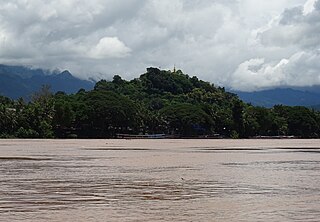
Mount Phou Si, also written Mount Phu Si, is a 100 m (328 ft) high hill in the centre of the old town of Luang Prabang in Laos. It lies in the heart of the old town peninsula and is bordered on one side by the Mekong River and on the other side by the Nam Khan River. The hill is a local religious site, and houses several Buddhist shrines.

Wat Sen, Luang Prabang also known as Wat Sene Souk Haram is a Buddhist temple (wat), located in Luang Phrabang, Laos.

Luang Prabang is a province in northern Laos. Its capital of the same name, Luang Prabang, was the capital of the Lan Xang Kingdom during the 13th to 16th centuries. It is listed since 1995 by UNESCO as a World Heritage Site for unique architectural, religious and cultural heritage, a blend of the rural and urban developments over several centuries, including the French colonial influences during the 19th and 20th centuries. The province has 12 districts. The Royal Palace, the national museum in the capital city, and the Phou Loei Protected Reserve are important sites. Notable temples in the province are the Wat Xieng Thong, Wat Wisunarat, Wat Sen, Wat Xieng Muan, and Wat Manorom. The Lao New Year is celebrated in April as The Bun Pi Mai.
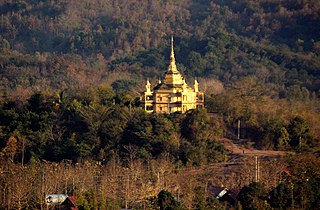
Wat Pa Phon Phao, also Wat Phon Phao, Wat Phonphao, or Wat Phol Phao, meaning "Peacefulness Temple", is a Buddhist temple situated on a hill in the southeast of Luang Prabang, Laos, across the Nam Khan River from Luang Prabang Airport. The temple, a golden stupa, is used as a forest meditation retreat, and was once headed by the abbot Ajahn Saisamut, a noted Lao Buddhist teacher. His funeral in 1992 was one of the largest funeral services Laos had ever seen. The temple has a fine collection of murals, some of them gruesome in nature.

Wat Hosian Voravihane is a Buddhist temple (wat) in Luang Prabang, Laos.
19°53′26″N102°8′5″E / 19.89056°N 102.13472°E